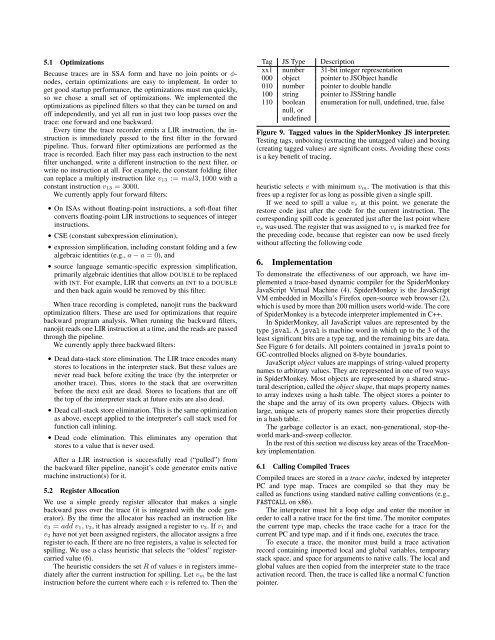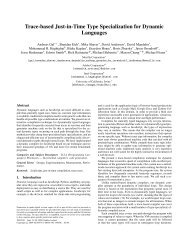compressed.tracemonkey-pldi-09
You also want an ePaper? Increase the reach of your titles
YUMPU automatically turns print PDFs into web optimized ePapers that Google loves.
5.1 Optimizations<br />
Because traces are in SSA form and have no join points or φ-<br />
nodes, certain optimizations are easy to implement. In order to<br />
get good startup performance, the optimizations must run quickly,<br />
so we chose a small set of optimizations. We implemented the<br />
optimizations as pipelined filters so that they can be turned on and<br />
off independently, and yet all run in just two loop passes over the<br />
trace: one forward and one backward.<br />
Every time the trace recorder emits a LIR instruction, the instruction<br />
is immediately passed to the first filter in the forward<br />
pipeline. Thus, forward filter optimizations are performed as the<br />
trace is recorded. Each filter may pass each instruction to the next<br />
filter unchanged, write a different instruction to the next filter, or<br />
write no instruction at all. For example, the constant folding filter<br />
can replace a multiply instruction like v 13 := mul3, 1000 with a<br />
constant instruction v 13 = 3000.<br />
We currently apply four forward filters:<br />
• On ISAs without floating-point instructions, a soft-float filter<br />
converts floating-point LIR instructions to sequences of integer<br />
instructions.<br />
• CSE (constant subexpression elimination),<br />
• expression simplification, including constant folding and a few<br />
algebraic identities (e.g., a − a = 0), and<br />
• source language semantic-specific expression simplification,<br />
primarily algebraic identities that allow DOUBLE to be replaced<br />
with INT. For example, LIR that converts an INT to a DOUBLE<br />
and then back again would be removed by this filter.<br />
When trace recording is completed, nanojit runs the backward<br />
optimization filters. These are used for optimizations that require<br />
backward program analysis. When running the backward filters,<br />
nanojit reads one LIR instruction at a time, and the reads are passed<br />
through the pipeline.<br />
We currently apply three backward filters:<br />
• Dead data-stack store elimination. The LIR trace encodes many<br />
stores to locations in the interpreter stack. But these values are<br />
never read back before exiting the trace (by the interpreter or<br />
another trace). Thus, stores to the stack that are overwritten<br />
before the next exit are dead. Stores to locations that are off<br />
the top of the interpreter stack at future exits are also dead.<br />
• Dead call-stack store elimination. This is the same optimization<br />
as above, except applied to the interpreter’s call stack used for<br />
function call inlining.<br />
• Dead code elimination. This eliminates any operation that<br />
stores to a value that is never used.<br />
After a LIR instruction is successfully read (“pulled”) from<br />
the backward filter pipeline, nanojit’s code generator emits native<br />
machine instruction(s) for it.<br />
5.2 Register Allocation<br />
We use a simple greedy register allocator that makes a single<br />
backward pass over the trace (it is integrated with the code generator).<br />
By the time the allocator has reached an instruction like<br />
v 3 = add v 1, v 2, it has already assigned a register to v 3. If v 1 and<br />
v 2 have not yet been assigned registers, the allocator assigns a free<br />
register to each. If there are no free registers, a value is selected for<br />
spilling. We use a class heuristic that selects the “oldest” registercarried<br />
value (6).<br />
The heuristic considers the set R of values v in registers immediately<br />
after the current instruction for spilling. Let v m be the last<br />
instruction before the current where each v is referred to. Then the<br />
Tag JS Type Description<br />
xx1 number 31-bit integer representation<br />
000 object pointer to JSObject handle<br />
010 number pointer to double handle<br />
100 string pointer to JSString handle<br />
110 boolean enumeration for null, undefined, true, false<br />
null, or<br />
undefined<br />
Figure 9. Tagged values in the SpiderMonkey JS interpreter.<br />
Testing tags, unboxing (extracting the untagged value) and boxing<br />
(creating tagged values) are significant costs. Avoiding these costs<br />
is a key benefit of tracing.<br />
heuristic selects v with minimum v m. The motivation is that this<br />
frees up a register for as long as possible given a single spill.<br />
If we need to spill a value v s at this point, we generate the<br />
restore code just after the code for the current instruction. The<br />
corresponding spill code is generated just after the last point where<br />
v s was used. The register that was assigned to v s is marked free for<br />
the preceding code, because that register can now be used freely<br />
without affecting the following code<br />
6. Implementation<br />
To demonstrate the effectiveness of our approach, we have implemented<br />
a trace-based dynamic compiler for the SpiderMonkey<br />
JavaScript Virtual Machine (4). SpiderMonkey is the JavaScript<br />
VM embedded in Mozilla’s Firefox open-source web browser (2),<br />
which is used by more than 200 million users world-wide. The core<br />
of SpiderMonkey is a bytecode interpreter implemented in C++.<br />
In SpiderMonkey, all JavaScript values are represented by the<br />
type jsval. A jsval is machine word in which up to the 3 of the<br />
least significant bits are a type tag, and the remaining bits are data.<br />
See Figure 6 for details. All pointers contained in jsvals point to<br />
GC-controlled blocks aligned on 8-byte boundaries.<br />
JavaScript object values are mappings of string-valued property<br />
names to arbitrary values. They are represented in one of two ways<br />
in SpiderMonkey. Most objects are represented by a shared structural<br />
description, called the object shape, that maps property names<br />
to array indexes using a hash table. The object stores a pointer to<br />
the shape and the array of its own property values. Objects with<br />
large, unique sets of property names store their properties directly<br />
in a hash table.<br />
The garbage collector is an exact, non-generational, stop-theworld<br />
mark-and-sweep collector.<br />
In the rest of this section we discuss key areas of the TraceMonkey<br />
implementation.<br />
6.1 Calling Compiled Traces<br />
Compiled traces are stored in a trace cache, indexed by intepreter<br />
PC and type map. Traces are compiled so that they may be<br />
called as functions using standard native calling conventions (e.g.,<br />
FASTCALL on x86).<br />
The interpreter must hit a loop edge and enter the monitor in<br />
order to call a native trace for the first time. The monitor computes<br />
the current type map, checks the trace cache for a trace for the<br />
current PC and type map, and if it finds one, executes the trace.<br />
To execute a trace, the monitor must build a trace activation<br />
record containing imported local and global variables, temporary<br />
stack space, and space for arguments to native calls. The local and<br />
global values are then copied from the interpreter state to the trace<br />
activation record. Then, the trace is called like a normal C function<br />
pointer.



